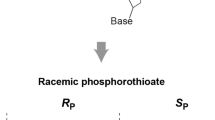Abstract
Protein–ligand titrations can readily be monitored with a trimethylsilyl (TMS) tag. Owing to the intensity, narrow line shape and unique chemical shift of a TMS group, dissociation constants can be determined from straightforward 1D 1H-NMR spectra not only in the fast but also in the slow exchange limit. The tag is easily attached to cysteine residues and a sensitive reporter of ligand binding also at sites where it does not interfere with ligand binding or catalytic efficiency of the target protein. Its utility is demonstrated for the Zika virus NS2B–NS3 protease and the human prolyl isomerase FK506 binding protein.








Similar content being viewed by others
References
Arntson KE, Pomerantz WC (2016) Protein-observed fluorine NMR: a bioorthogonal approach for small molecule discovery. J Med Chem 59:5158–5171
Bierer BE, Mattila PS, Standaert RF, Herzenberg LA, Burakoff SJ, Crabtree G, Schreiber SL (1990) Two distinct signal transmission pathways in T lymphocytes are inhibited by complexes formed between an immunophilin and either FK506 or rapamycin. Proc Natl Acad Sci USA 87:9231–9235
Boldescu V, Behnam MAM, Vasilakis N, Klein CD (2017) Broad-spectrum agents for flaviviral infections: dengue, Zika and beyond. Nat Rev Drug Discov 16:565–586
Bonner JM, Boulianne GL (2017) Diverse structures, functions and uses of FK506 binding proteins. Cell Signal 38:97–105
Brecher M, Li Z, Liu B, Zhang J, Koetzner CA, Alifarag A, Jones SA, Lin Q, Kramer LD, Li H (2017) A conformational switch high-throughput screening assay and allosteric inhibition of the flavivirus NS2B-NS3 protease. PLoS Pathog 13:e1006411
Cellitti SE, Jones DH, Lagpacan L, Hao X, Zhang Q, Hu H, Brittain SM, Brinker A, Caldwell J, Bursulaya B, Spraggon G, Brock A, Ryu Y, Uno T, Schultz PG, Geierstanger BH (2008) In vivo incorporation of unnatural amino acids to probe structure, dynamics, and ligand binding in a large protein by nuclear magnetic resonance spectroscopy. J Am Chem Soc 130:9268–9281
Chen WN, Kuppan KV, Lee MD, Jaudzems K, Huber T, Otting G (2015) O-tert-Butyltyrosine, an NMR tag for high-molecular-weight systems and measurements of submicromolar ligand binding affinities. J Am Chem Soc 137:4581–4586
Chen WN, Nitsche C, Pilla KB, Graham B, Huber T, Klein CD, Otting G (2016) Sensitive NMR approach for determining the binding mode of tightly binding ligand molecules to protein targets. J Am Chem Soc 138:4539–4546
de la Cruz L, Nguyen TH, Ozawa K, Shin J, Graham B, Huber T, Otting G (2011) Binding of low molecular weight inhibitors promotes large conformational changes in the dengue virus NS2B-NS3 protease: fold analysis by pseudocontact shifts. J Am Chem Soc 133:19205–19215
Doak BC, Norton RS, Scanlon MJ (2016) The ways and means of fragment-based drug design. Pharmacol Ther 167:28–37
Gossert AD, Jahnke W (2016) NMR in drug discovery: a practical guide to identification and validation of ligands interacting with biological macromolecules. Prog Nucl Magn Reson Spectrosc 97:82–125
Hwang TL, Shaka AJ (1995) Water suppression that works. Excitation sculpting using arbitrary wave-forms and pulsed-field gradients. J Magn Reson Ser A 112:275–279
Jabar S, Adams LA, Wang Y, Aurelio L, Graham B, Otting G (2017) Chemical tagging with tert-butyl and trimethylsilyl groups for measuring intermolecular nuclear Overhauser effects in a large protein-ligand complex. Chem Eur J 23:13033–13036
Jackson JC, Hammill JT, Mehl RA (2007) Site-specific incorporation of a 19F-amino acid into proteins as an NMR probe for characterizing protein structure and reactivity. J Am Chem Soc 129:1160–1166
Lei J, Hansen G, Nitsche C, Klein CD, Zhang L, Hilgenfeld R (2016) Crystal structure of Zika virus NS2B-NS3 protease in complex with a boronate inhibitor. Science 353:503–505
Lim L, Roy A, Song J (2016) Identification of a Zika NS2B-NS3pro pocket susceptible to allosteric inhibition by small molecules including qucertin rich in edible plants. bioRxiv
Liu JJ, Horst R, Katritch V, Stevens RC, Wüthrich K (2012) Biased signaling pathways in β2-adrenergic receptor characterized by 19F-NMR. Science 335:1106–1110
Loh C-T, Adams LA, Graham B, Otting G (2018) Genetically encoded amino acids with tert-butyl and trimethylsilyl groups for site-selective studies of proteins by NMR spectroscopy. J Biomol NMR. https://doi.org/10.1007/s10858-017-0157-y
Mahawaththa MC, Pearce BJG, Szabo M, Graham B, Klein CD, Nitsche C, Otting G (2017) Solution conformations of a linked construct of the Zika virus NS2B-NS3 protease. Antiviral Res 142:141–147
Neylon C, Brown SE, Kralicek AV, Miles CS, Love CA, Dixon NE (2000) Interaction of the Escherichia coli replication terminator protein (Tus) with DNA: a model derived from DNA-binding studies of mutant proteins by surface plasmon resonance. Biochemistry 39:11989–11999
Nitsche C, Otting G (2018) NMR studies of ligand binding. Curr Opin Struct Biol 48:16–22
Nitsche C, Holloway S, Schirmeister T, Klein CD (2014) Biochemistry and medicinal chemistry of the dengue virus protease. Chem Rev 114:11348–11381
Nitsche C, Mahawaththa MC, Becker W, Huber T, Otting G (2017) Site-selective tagging of proteins by pnictogen-mediated self-assembly. Chem Commun 53:10894–10897
Shuker SB, Hajduk PJ, Meadows RP, Fesik SW (1996) Discovering high-affinity ligands for proteins: SAR by NMR. Science 274:1531–1534
Siekierka JJ, Hung SH, Poe M, Lin CS, Sigal NH (1989) A cytosolic binding protein for the immunosuppressant FK506 has peptidyl-prolyl isomerase activity but is distinct from cyclophilin. Nature 341:755–757
Acknowledgements
We thank Mr Mithun Chamikara Mahawaththa for mass spectrometry measurements and Professor Rolf Hilgenfeld for providing a sample of the substrate Bz-Nle-Lys-Lys-Arg-AMC. C.N. and G.O. thank the Alexander von Humboldt Foundation for a Feodor Lynen Fellowship and the Australian Research Council for a Laureate Fellowship, respectively. Financial project support by the Australian Research Council, the Austrian Science Fund (FWF) (DK Molecular Enzymology W901 to K.Z.) and by NAWI Graz is gratefully acknowledged.
Author information
Authors and Affiliations
Corresponding author
Electronic supplementary material
Below is the link to the electronic supplementary material.
Rights and permissions
About this article
Cite this article
Becker, W., Adams, L.A., Graham, B. et al. Trimethylsilyl tag for probing protein–ligand interactions by NMR. J Biomol NMR 70, 211–218 (2018). https://doi.org/10.1007/s10858-018-0173-6
Received:
Accepted:
Published:
Issue Date:
DOI: https://doi.org/10.1007/s10858-018-0173-6




